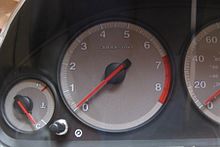


Anair core gauge is a specific type of rotary actuator in an analog display gauge that allows an indicator to rotate a full 360 degrees. It is used in gauges and displays, most commonly automotive instrument clusters.
A typical automotive application is shown at the right. The air core gauge is a type of "air-core motor". It may be considered a "gauge movement" or "pointer indication device".[1]
There are four common types of rotary actuators:[2]
The air core gauge consists of two independent, perpendicular coils surrounding a hollow chamber. A needle shaft protrudes into the chamber, where a permanent magnet is affixed to the shaft. When current flows through the perpendicular coils, their magnetic fields superimpose and the magnet is free to align with the combined fields.

A typical air core gauge has four terminals, two for each coil, as shown. The two coils are identified as the sine coil and the cosine coil.
The direction 

Where 


If the sin coil current is 29 mA and the cos current is 50 mA:
The coil current ratio is 0.58, and arctan 0.58 = 30 degrees.
Air core gauges require special electronics to properly drive the coils. Some driver integrated circuits have a serial input data port and two pair of output lines. One pair of the output lines drives the sin coil and one pair drives the cos coil.
The input data defines:
Some typical driver ICs include: